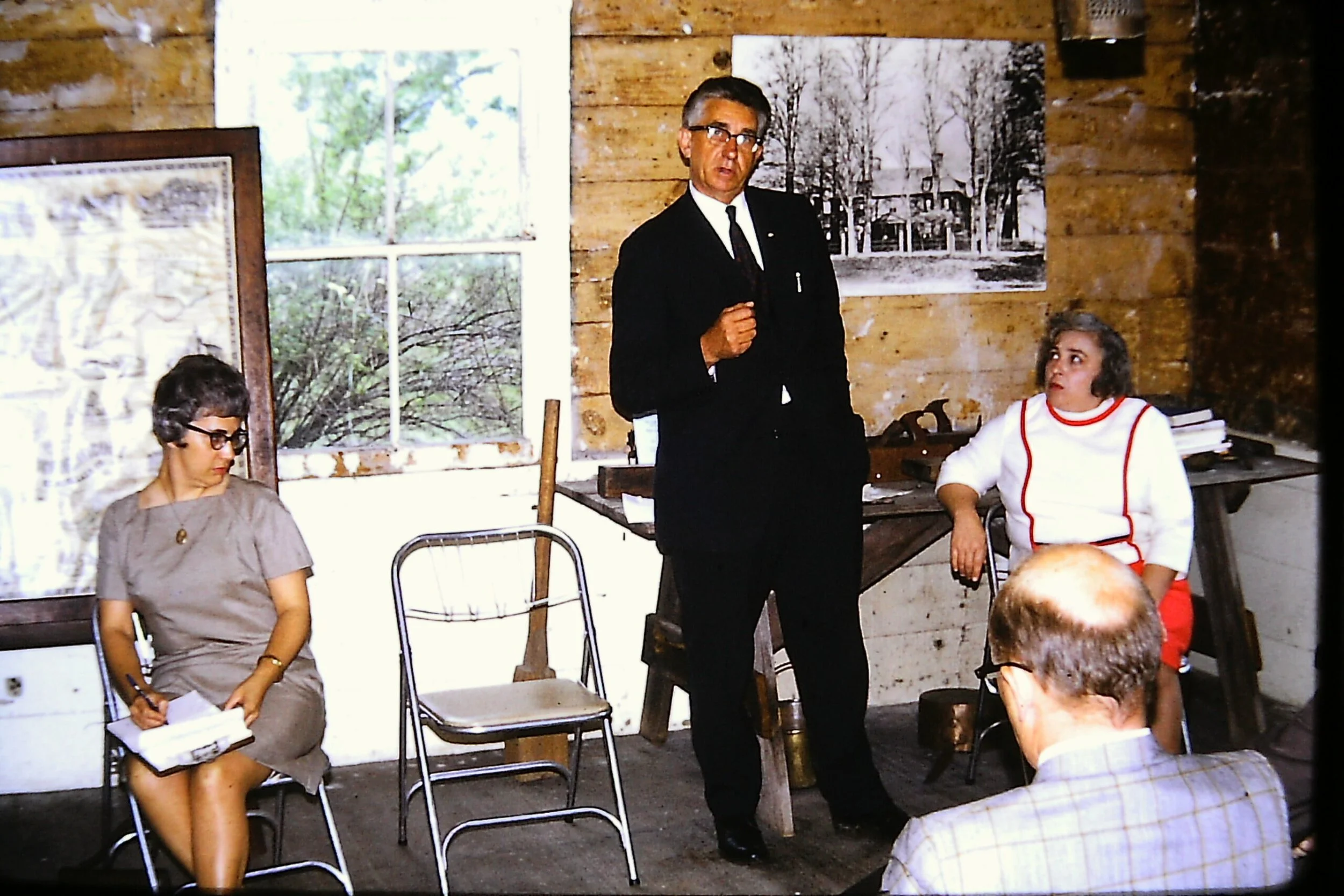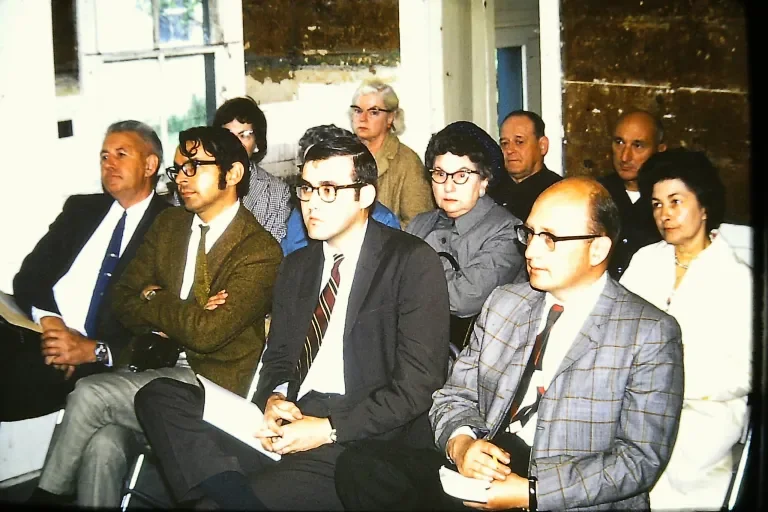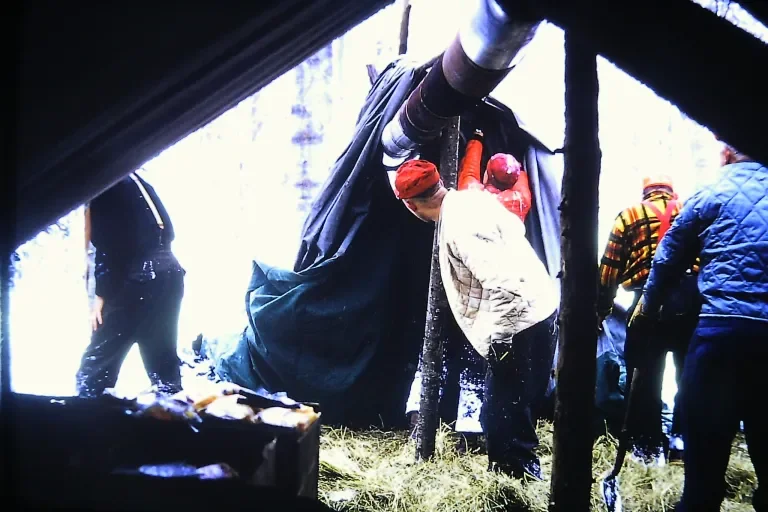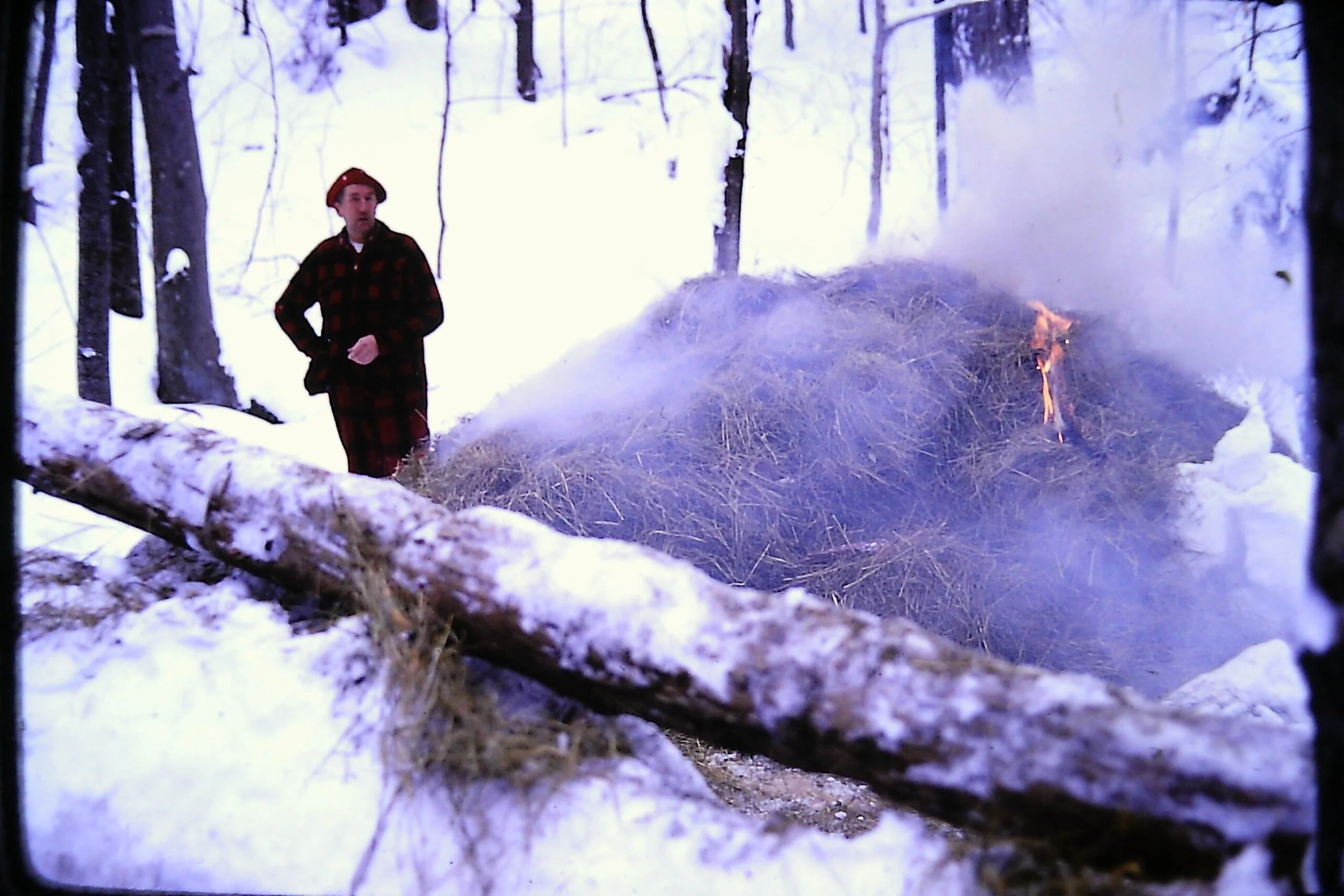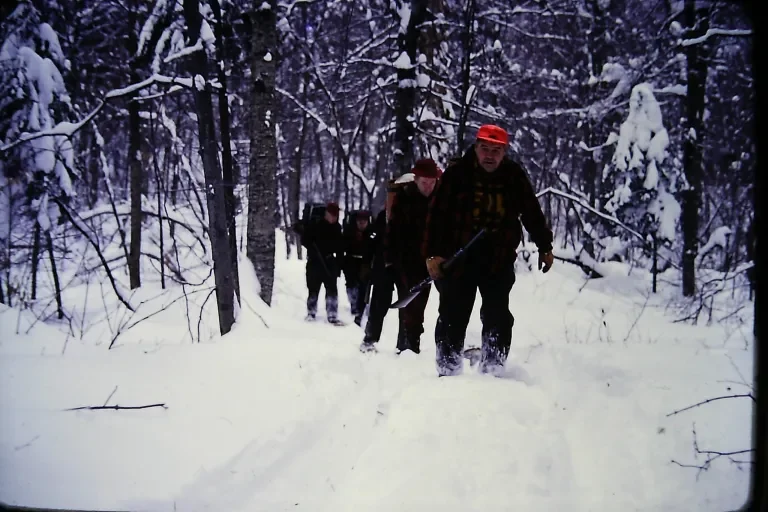Remembering Paul Schaefer: Camp Life at the Cataract Club
Paul Schaefer was perhaps the most famous Adirondack conservation “hero” of the twentieth century, the citizen-advocate who took on Albany on a number of Forest Preserve issues – and won. He hiked, he owned property, and he wrote. He is credited with the first known winter ascent of Crane Mountain in Warren County, and he tirelessly traveled the state to present the top issues concerning the Adirondack Park to civics-minded groups everywhere.
But come late autumn, Paul Schaefer was a hunter. An organizer by nature, he founded the group called the Cataract Club in 1933 as an informal association of backcountry deer hunters, gathering every year at the same chosen spot near Bakers Mills. Located on Diamond Brook in what is now the Siamese Ponds Wilderness, the camp was a mobile affair: hauled in by wagon at the beginning of each season, and removed by similar means at the close.[1]
On a rainy May morning I drove out to North Creek to speak with two of the surviving members of the Cataract Club – two men whom Schaefer had invited into the fold more than a decade apart from each other, but who now remain friends. We met in the woods above the Hudson River – one of the mighty waterways Paul had worked to protect – and gathered around a table tucked away in a snug bunkhouse.
Arnie Wyse was a 1977 addition to the Cataract Club, by which time it had already been an “institution” for more than forty years. Originally from Michigan and the son of a Mennonite minister, Wyse first became acquainted with the Adirondacks in 1968 while doing his residency towards a doctorate in psychiatry. The woods and waters immediately agreed with him. “It was like rediscovering Michigan,” he said of the experience.
He purchased property in the Adirondacks in 1973, but this turned out to be only the first of several acquisitions. A key moment came in 1977 when he bought an undeveloped parcel on Edwards Hill Road in Bakers Mills, a tiny hamlet with a sleepy appearance that belies its importance in the history of wilderness preservation – not just regionally, but nationally[2].
Wyse got title to this lot for a pittance at a tax sale. There was no cabin, just a frog pond, and it abutted one of the traditional access routes leading into the nearby wilderness. And as it just so happened, it made this former Michigander neighbors with a certain other camp owner of note.
“I think Paul really just wanted to check us out,” Wyse recalled years later in his North Creek bunkhouse. By “us” he meant his sons and father, who were also present that day.
Schaefer, of course, owned a camp of his own farther up the road – the Beaver House, a rustic retreat he had built himself in the early 1960s, with assistance from his brother Carl. Among the materials used in its construction were hand-hewn beams salvaged from an ancient building that had once been part of Albany’s colonial trade in beaver pelts. The Beaver House stood practically on the edge of the wilderness he had been exploring for decades.
Wyse recalls that his new neighbor was very open and generous. Seeing he had no cabin of his own, Schaefer invited him and his family to use the Beaver House – and when the conversation turned to hunting, Wyse walked away from that encounter with an additional invitation to join Paul and crew at Diamond Brook later that fall.
In November, Wyse took him up on that offer. Accompanied by his sons, who were aged 14 and 16 at the time, Wyse made the journey up to Bakers Mills on a Friday night. At this point he didn’t know anyone else in the Cataract Club, only Paul Schaefer, who had said to meet him at 8 PM. The location, though, turned out to be something of a mix-up: the Wyses assumed they were to meet their host at the Beaver House, but meanwhile Schaefer and his companions were quaffing drinks at J&J’s Tavern in town[3].
“It was a cold night!” Wyse said of the long wait before he and his sons finally met up with Paul and the other club members.
Getting to the Cataract Club’s backcountry camp required a hike of several miles down an unmarked trail. By the time the crew got started, it was quite late – and dark. Therefore the journey was made entirely by flashlight.
But this nocturnal hike was the official beginning of “Deer Week” ’77.
A Backcountry Tradition
The Cataract Club was not a formal organization with charter members and bylaws. There was no tar-paper cabin standing on a paper company lease. The camp was a surplus Army squad tent erected each season on the same campsite located high in a valley on the back side of Eleventh Mountain. “Membership” in the club was an open-ended arrangement, with some returning faces and many new ones – not unlike Arnie Wyse and his two teenaged sons.
This was a remote location in the Forest Preserve, so the only way in or out was by foot or by horse. The men traveled by foot, but the gear was hauled in each year by Earl Allen, a local teamster and “homesteader” on Edwards Hill Road. A true Adirondacker, Allen operated a sugarbush and drew pay as a general handyman, but he also owned a team of draft horses and a buckboard wagon. Remember, this was 1977, the same year that Abba’s “Dancing Queen” was topping the pop charts and the world had its first exposure to Star Wars; a century prior, buckboards were the primary mode of travel through the woods, but they were of course a rare anachronism during the “Disco Era.”
Diamond Brook Campsite
Earl Allen and his Draft Horses
For a price, Allen would haul in everything the club would need – except the cast-iron stove, which Schaefer and crew hid on site when not in use. Camp would be set up the weekend before the big game season started, and it would be occupied mostly on weekends – Friday night through Sunday. But the second full week of November was Deer Week, which spanned from Friday through the second Sunday.
Not that everyone would necessarily stay the entire week; in fact, most didn’t, including Paul Schaefer himself, who had a construction business to run back home. But at any given time there might be six to nine men at Diamond Brook.
One of the people Arnie Wyse met at Diamond Brook that week was Rey Wells, who had been a Cataract Club regular since the ill-fated (and short-lived) ’68 season.
Like many people from the Schenectady area at the time, Wells was an employee of General Electric. Originally from Springfield, Massachusetts, he became a chemical engineer for GE in 1966, working in the same department as Don Brightman, who just happened to be an associate of Paul Schaefer. “We just struck up a friendship based on similar interests that we discovered during conversation,” Wells wrote me later of Brightman. It was through this connection that Rey had become involved with the Adirondack Hudson River Association.
This is a reference to the second of Schaefer’s two major river preservation efforts. In the 1940s, he had successfully convinced Albany to drop its plans to dam the South Branch of the Moose River, only to face a similar uphill battle on the Hudson River in the 1960s.
As Wells recalled, the state experienced a dry period that stressed New York City’s water supply system. Backed by the Army Corp of Engineers, the city sought access to the Hudson Gorge near Indian Lake for the purposes of building a reservoir, with dam construction proposed at a site near Kettle Mountain. This would’ve flooded some 28 miles of river and displaced portions of the hamlet of Newcomb.
By this point in Paul’s life his children were all grown, Wells said, therefore he was “all in” to save the Hudson River[4]. The Adirondack Hudson River Association was small, and much of it consisted of GE professionals like Wells and Brightman – but it was powerful because of the energy Paul Schaefer was willing to devote to the project. As Wells told me later, “I was amazed what one hard-driving and somewhat charismatic individual could accomplish with the aid of a small handful of dedicated volunteers.”
Paul Schaefer Speaking on Behalf of the Hudson
Upper Hudson Audience
Schaefer and his colleagues took many photos of the Hudson Gorge, and then traveled the state to put on presentations. This was, of course, several years before there was such a thing as an Adirondack Park Agency or State Environmental Quality Review Act; public hearings were not automatically part of the dam-building process, thus if Schaefer’s group didn’t directly act to influence public opinion, the bureaucratic machine likely would have steamrolled straight through the wild Hudson Gorge.
Of course the Adirondack Hudson River Association was successful, and not only was the dam proposal thwarted, but today the river segment in question is a state-designated Wild River within the state-designated Hudson Gorge Wilderness; the management concerns there now (happily) revolve around a bustling whitewater rafting industry and its relationship to cold-water brook trout refugia. In other words, if this is the worst problem today’s wilderness advocates must eventually reconcile, it is a good problem to have, all things considered.
What makes all this germane to the current story, however, is that a young man named Rey Wells, recently transplanted to New York State and clearly displaying a deep interest in wild aspects of the Adirondack Park, spent a lot of time following in the footsteps of Paul Schaefer, a conservation legend. And in 1968, Schaefer invited the younger man to deer camp.
The Snows of ‘68
That first Deer Week was perhaps the most memorable for Wells, but for all the wrong reasons.
The snow started falling early that year, and in amounts that are difficult to imagine in this current age of cold-but-short winters. Freakish blizzards could dump prodigious amounts of snow every so often, a trend that continued into the early 1970s before coming to a permanent halt within my own lifetime. The last notable Upstate blizzard was Valentine’s Day 2007, but that only resulted in 48 inches or so; a few years later in 2016, the Adirondack Park observed an entire winter season with hardly any snow accumulation at all.
The current “normal” is a prolonged bout of freezing weather with enough snow to sustain all the traditional winter sports, but with prolonged shoulder seasons that may extend into early January and resume in mid-March.
What happened in November 1968 wasn’t a blizzard, but it was a significant early snowfall. Immediately before Deer Week was to commence, Paul Schaefer got a call. It was Forest Ranger Chuck Severance; a foot of heavy, new snow had fallen in the woods in a storm that began on Thursday and extended into Friday, and he advised Schaefer not to go into camp.
Not entirely deterred, Schaefer headed up to Bakers Mills anyway on Saturday, along with Rey Wells, to check on camp and re-erect the tent if necessary. The two arrived in the afternoon, several hours behind a few other guys who had arrived in the morning. Schaefer and Wells arrived to find a restored tent and a welcoming fire in the woodstove.
Despite the early date, snowshoes were already required to get around. And somewhat more despairing to these hunters, there were no deer tracks in the snow – nothing was on the move. And in all likelihood, conditions were not going to improve. If Deer Week was to happen, there’d need to be snowshoes for everyone.
As the new guy, Wells was designated to return to Schenectady with a vital assignment: round up as many pairs of snowshoes as he could. On Sunday, he trudged back to Diamond Brook with six sets strapped to his back.
Earl Allen, the Bakers Mills native, was one of the invitees for the week. As planned, he arrived at camp on a cold Monday morning and hunted on snowshoes with the club members for a few hours before returning to the warm tent.
More than half a century later, sitting in the bunkhouse on Arnie Wyse’s property in North Creek, Wells recalled that the local teamster had come with a message: more snow was in the forecast that week, and therefore he could either haul out the Cataract Club’s gear the next day – or he could do it next April. Those were the choices.
Paul Schaefer was smart about the situation and agreed to the “next day” alternative; it was clearly starting off to be a hard winter, and as already mentioned there were few signs of deer anyway. Therefore on Tuesday, camp was struck. Rey Wells, the rookie of that aborted season, photographed the process on Kodachrome slides.
Taking Down the Tent
Burning the Hay
Arrival of Earl Allen
Snowshoeing Out
Cataract Club Members (Paul Schaefer standing on right)
And so the ’68 season ended before it really got started, but for Wells this was just the beginning of a long association with the Cataract Club.
Camp Traditions
The Cataract Club was one of several backcountry hunting traditions with deep roots in the area, enabled in part by the forest’s history.
Much of what is now the Siamese Ponds Wilderness was once the logging fiefdom of the Glens Falls lumber baron Zenas Van Dusen, and as such the East Branch Sacandaga watershed was penetrated by wagon roads and dotted with camps. Several families made an attempt at permanent settlement at a place still called Curtis Clearing, and Henry Maxam operated a popular sportsmen’s retreat at Old Farm Clearing. This latter site may have had much older origins: an 1858 map of Warren County clearly identifies that same spot as an “Indian Settlement.”
The state now owns a solid block of land in excess of 112,000 acres here. This is no patchwork state forest with graded service roads and Scotch pines planted in neat rows, but a legitimate wilderness that stretches from Bakers Mills to the east shore of Indian Lake. Even so, the legacy of its nineteenth-century human presence is a network of trails that were originally cut as rough wagon roads, and the nature of the trail system is what enabled the following century’s custom of hauling in elaborate camping set-ups by wagon.
Just over the mountain from Diamond Brook is a stream called Cross Brook on modern topographic maps, but which was locally known by its full name: Matt Cross Brook. In 1984, Daisy Allen (wife of Earl Allen) provided a thumbnail sketch of the Cross Brook Hunting Club on the occasion of its fiftieth anniversary in the Warrensburg-Lake George News[5]. Made up of men from the Catskills, it was still regarded as “large” at the time (with sixteen members hunting along the brook during that golden anniversary year) even though only two founding members still survived, one of whom was in a nursing home.
The Cross Brook site can still be found, although in the current century it appears far less frequented. Similar sites near Pine Mountain and Buck Meadow Flow were both accessed from the same trail, although the latter site has been abandoned for many years now. The use of teamsters to access the deep wilderness interior may have declined sharply during the Internet Era, but the route remains a designated horse trail nevertheless, from Old Farm Road all the way south to Cross Brook.
Thus Paul Schaefer’s Cataract Club was part of a larger tradition, with several well-spaced neighbors. Rather than the “main” trail running south from Old Farm, though, the route to the Diamond Brook site began directly on Edwards Hill Road – just down the road (literally) from the Beaver House. Start as if heading to Bog Meadow, but then take the left at the height-of-land. Can’t miss it.
For long-time members like Arnie Wyse and Rey Wells, those Novembers spent in camp still seem to remain front of mind. As we sat around the bunkhouse table, I quickly realized their memories of the camp layout remained so high-resolution that I would be able to draw a diagram of the place.
While there may have been several tents over the many years, the camp was arranged the exact same way every fall. Traditions mean everything in the sport of hunting – that sense of connection with the past and the comfort of knowing the future will be just as well-ordered. A woodpile stood just outside the tent flaps, to the right as one stood ready to enter, with a smaller pile of wood at the ready just inside, also on the right.
A bench-lined table big enough to accommodate everyone stood to the left, and the woodstove was to the right. Another bench stood just beside the woodstove. “The end of the bench that nearly touched the stove was the best seat in the house if it was cold and the fire was new,” Wells said. “Or it was the worst if the fire was mature and hot. Such always became the case when Paul stoked the fire later in the evening and headed back to his sleeping bag.”
A log lay width-wise across the ground, marking the boundary between eating and sleeping areas. The latter zone was a bed of plywood covered in straw. A stovepipe ran up to the tent’s ridgeline, then followed it to an exit cut out of the back wall, thus providing a conduit for heat through the entire space.
Paul liked his tents hot; one could count on his tendencies to load up the stove before retiring to bed at night. Sometimes people would be sweating at night, but freezing in the morning if no one had restocked the stove during the long dark hours. In the later years, when Schaefer was just as apt to nap during the day as he was to join a drive for deer, he would still fill up the woodstove before settling down.
In some respects, though, the Cataract Club straddled the line between modern and traditional. For instance, thanks to all the General Electric connections, the camp was stocked with spun stainless steel kitchenware, from the plates to the enormous dishpan in which they were washed. On the other hand, water was obtained directly from nearby Diamond Brook and heated on the woodstove. Newer members tended to do the dishes; if someone bathed themselves from the almost tub-sized dishpan it was best not to dwell on the hygienic implications.
Barking Drives
The traditional deer-hunting method was something called the “barking drive.” Several men would be posted as “sitters” or “watchers” some distance off in the woods, and a few more would walk in their direction, making a noise as they did so. “There were almost always more watchers than drivers,” Wells recalled. The drivers would be abreast of each other, but only just within sight of the next man; in theory, any deer between them and the sitters would eventually be flushed out of hiding. If no whitetails appeared, then the sitters would call to the others just as they came even of each other; the men might sit and rest for a bit before reversing the process back toward camp.
Like many such groups, they possessed a sense of geographic orientation that might befuddle the uninitiated. Club members spoke of toponyms that one would be hard-pressed to locate on any published map, then or now: Bear Brook, Deer Brook, Cliff Swamp, Hardwood Ridge, and so forth. Arnie and Rey casually tossed names like these about as their fingers drew lines across the large, detailed USGS-based map I had brought to the interview – the same map I use for my own adventures in this area. If, like me, you had not participated in a Cataract Club hunt, these names would not be of much help, but to club veterans these were key landmarks – not to mention vividly remembered places, often.
Even the name of the club itself was a product of this Colvin-like attitude toward place names. The largest feature in the camp’s vicinity – and the one that shielded it from the outside world – is officially named Eleventh Mountain, a result of its prominence in the old Township 11, one of the post-colonial land surveys. Almost a range unto itself, Eleventh is a multi-summited ridge occupying the vast space between Bakers Mills and the nearest corner of the East Branch Sacandaga.
Some of the more notable features of this mountain are the streams that tumble down its broad slopes, including one high-elevation waterfall that is directly visible from NY 8. Paul Schaefer and his companions knew of several other “cataracts” on the mountain’s northern slopes, thus the place was better known to them as “Cataract Mountain.” Once this fact is understood, the club’s name makes perfect sense.
Paul Schaefer was the recognized leader of this group, as well as its originator and longest-serving member. The state permits required for each year’s month-long stay were issued in his name, and it was Paul’s tendency to latch onto the people he met throughout his life that ultimately brought such a mix of personal backgrounds to Diamond Brook.
Paul Schaefer Warming his Hands
Politics (and women) were not much talked about; as Arnie and Rey jointly pointed out to me, back then politics were not such a divisive topic. Everybody in the Cataract Club had a love for the outdoors, and mostly got along. In the combined memory of both men, only one guest at Diamond Brook rubbed the hunters the wrong way with his boastful attitude, and this unnamed individual was explicitly asked – in writing – never to return. Otherwise, this was a place where men built lasting friendships.
Southern Comfort was the drink of choice, and again this might’ve been another Paul Schaefer influence. By all accounts this liqueur was his personal favorite. “We all sipped it,” Wells told me, but no one over-imbibed, “maybe because we usually had only one bottle, and it had to last the week. Also, no one wanted to hunt with anyone who was hung over.”
The mutual nickname for the drink was Northern Misery. “Any time it was uttered,” he said, “chuckles ensued.”
By Paul’s decree, this was strictly a “bucks only” club; does were never a legitimate quarry, even during the times when doe hunting was permitted by the state. And it seems that “doe” was not necessarily a binary gender concept, either. One day a younger guy shot a “button buck,” referring to a male deer whose antlers had only just begun to sprout. This conquest greatly angered Schaefer, who argued that the button-sized antlers had been too small to see from a distance – meaning that at the moment the offending hunter had pulled his trigger, he had been shooting at a doe for all he knew.
Justice was meted out. Someone cut off one of the button-buck’s hindquarters, and from that point further the young hunter had to bear this weight draped over his shoulders. Suffice it to say, he too never returned to Diamond Brook.
One night, perhaps with the inspiration of some Southern Comfort already under his belt, Paul was sermonizing on what he perceived as the superior intelligence of the whitetail deer, especially in regards to the ways of the wilderness. This provoked a reaction from Arnie Wyse. “If that’s so,” he challenged, “then how come we’re eating them?”
One can imagine Schaefer mumbling a response into his drink.
Rey Wells remembers another experience that transpired on a wet, cold day. Paul’s leather gloves had gotten soaked during the course of the day’s proceedings, and were therefore too uncomfortable to wear. He asked Rey to dry them out over the fire, and – well, perhaps you can already see where this is going.
The younger man propped the gloves on the ends of sticks just a little too close to the heat, and for too long a time. Both items shriveled to an unusable size.
“‘The boys’ had a good laugh at my expense – and Paul’s,” Wells recalled. “Paul did not show any sign he was upset with me, as I was otherwise in great favor in those days.
“Also, maybe he realized that he should have tended to his own gloves.”
The Rabbits of Chatiemac
Being a builder by trade, Paul Schaefer over time built his way through a portion of the Johnsburg real estate scene. The Beaver House was the first camp, but he also built a second camp on Chatiemac Road, located clear on the other side of Edwards Hill. For a while he tended to favor this site over Beaver House.
Some of the people who frequented Diamond Brook also joined Schaefer at Chatiemac Road in March to go rabbit hunting, and this became one of the ancillary club traditions in its later years – just like the annual deer roast at Paul’s primary residence on St. David’s Lane in Niskayuna.
However, neither tradition was destined to last forever. Rey Wells theorizes that Paul sold the Chatiemac Road cabin because he needed the money. He had been so dedicated to the Adirondacks throughout his career – and some might say dedicated to a fault – that he had a tendency to neglect his business affairs.
Chatiemac Road Cabin
Fireplace at Chatiemac
Wells, who had been brought into the fold during the Hudson River campaign, felt as though Paul – a lifelong admirer of people like Howard Zahniser and especially Bob Marshall – was grooming the chemical engineer to become his eventual successor. But here there was a fundamental difference between the two men that ran deeper than a love for the Adirondacks; whereas Paul had sacrificed much personally during the course of his long career, Wells was a family man with well-defined limits on the amount of time he was willing to devote. Therefore the successor role eventually fell to Dave Gibson.
After the sale of the Chatiemac cabin, the rabbit hunts became based out of the Beaver House. But overall, Paul’s advancing age was becoming a clear impediment to his sporting pursuits, and in the later years he spent more time camping than he did hunting. One of his knees was deteriorating – the result of an injury sustained during a dory ride down the Hudson long before – and a stunning moment came when Paul Schaefer had no choice but to ride Earl Allen’s buckboard wagon out of Diamond Brook one fall.
It goes without saying that to anyone’s memory, this had never happened before in the history of the Cataract Club. It was by no means a relaxing ride, as the trail itself was anything but smooth and buckboards were never known as sources of comfort, even in their native century. Walking out of the woods on one’s own two feet was the universal preference, and so if Paul chose to climb onto Earl Allen’s wagon everyone present knew he was hurting in a bad way.
Schaefer died in 1996, not long after undergoing knee replacement surgery.
The club didn’t die with him, though; a contingent of hunters – including Arnie Wyse – kept returning to Diamond Brook as recently as 2015[6], before switching to the Beaver House as their basecamp. But other traditions proved impossible to sustain without Paul Schaefer’s presence. Specifically, both Arnie and Rey pointed to the annual deer roast at Schaefer’s Niskayuna home, which was converted into the Adirondack Research Library after his death.
At first, the library was managed by the Association for the Protection of the Adirondacks (AfPA), with Dave Gibson as its executive director. Gibson remained a good friend of the club for many years later, and he made it possible for the group to continue using Schaefer’s home for the annual roast.
But the financial burden of maintaining the library was a contributing factor that set that century-old organization on a collision course with the Resident’s Committee for the Protection of the Adirondacks (RCPA). These organizations merged in 2009 to become Protect the Adirondacks!, a portmanteau of sorts that combined the common words of both legacy names, with the exclamation mark added for deliberate emphasis. Soon the library – literally, Paul Schaefer’s home – was excised from the new organization’s list of assets; today it is operated by Union College.
At some point during the mergers and transfer, St. David’s Lane suddenly became unavailable for the venison roast, and one long-standing camp tradition came to an inglorious end. Arnie and Rey point to this event as the specific moment when they no longer felt welcome in Paul Schaefer’s former home – and they are certain this is not what Paul would have wanted.
All photos courtesy of Rey Wells
END NOTES
[1] Paul Schaefer’s own account of his hunting club’s history can be found in Adirondack Cabin Country (Syracuse University Press, 1993)
[2] Another noteworthy camp owner here was Howard Zahniser, author and champion of the 1964 Wilderness Act. Zahniser and Schaefer were close friends, therefore it is no coincidence both men established camps here.
[3] This establishment still exists, but is currently closed.
[4] Schaefer’s own family would quibble at the nuances of this statement; in all likelihood, they say, Paul would’ve been “all in” regardless of the age of his children. But this discussion might be best saved for a future article.
[5] Read the full article here.
[6] Wyse says he eventually had to bow out of the club due to age and health concerns.




